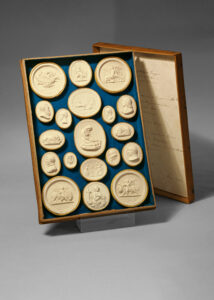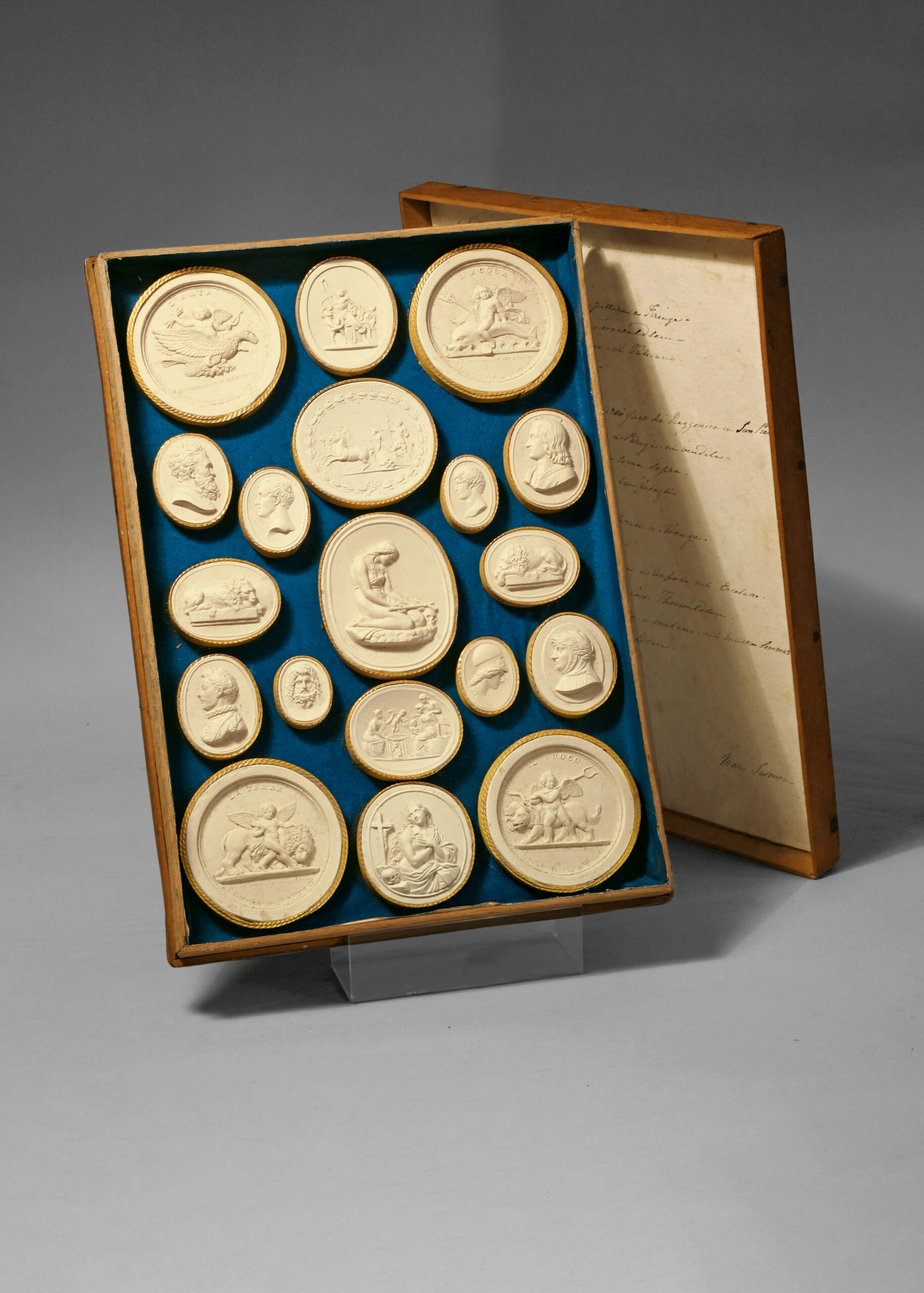Rome, c. 1820.
The plaster casts are bordered with folded and hand-gilded paper, mounted on a blue paper backing, as issued by Giovanni Liberotti. A paper sheet listing in Italian the 19 works represented on the cameos is glued inside the lid (as published) with the purchaser’s name Mary Salmon written at the bottom, in very good condition.
Box dimensions: 304 x 213 mm.
These plaster cameos are part of a collection made in Rome around 1820 by Giovanni Liberotti. They reproduce a selection of architecture and famous works of art visible in Rome, Florence, Milan, Paris, and in some major private collections.
Placed in easily transportable wooden boxes and accompanied by captions, such sets were sold to wealthy European travelers visiting Italy as part of the Grand Tour.
Rome was the ultimate destination, and a visit to the treasures in its many museums completed a young man’s education. The collection of boxes containing plaster molds of classical works of art was a fashionable pastime and a valuable ‘memory aid’ for the mythologies, gods, and historical events represented on the delicate cameos.
Les Liberotti Printedby was marketed by Giovanni Liberotti, a Roman gem engraver who specialized in making these souvenirs. They were then sold in series, representing works by sculptors of the time such as Canova or Thorvaldsen, as well as painters like Leonardo da Vinci. Each box contained plaster cameos mounted opposite a handwritten list of the works.
This set of nineteen plaster impressions of intaglios, mainly representing classical subjects, was made in Rome around 1820.
On the inside face of the lid is the handwritten list of titles of the works represented:
1 – L’Aria, Thorvaldsen
2 – Laocoon, at the Vatican
3 – L’acqua, Thorvaldsen
4 – Michelangelo, from a painting in Florence
5 – Il Triumph of Alexander, Thorvaldsen
6 – Raphael Sanzo de Urbino, at the Vatican
7 – Il Marquis, Canova
8 – Il Cav. , Thorvaldsen
9 – Il lion by Canova
10 – Mary Magdalene, Canova in Paris for sale
11 – Another Lion by Canova
12 – Torquato Tasso at the Capitol Museum
13 – Il Jupiter
14 – La Minerva in the Gallery in Florence
15 – Petrarch at the Capitol
16 – La Merchantess oflove in Naples
17 – Earth elements by Cav. Thorvaldsen
18 – La Magdalene by Guido in Milan
19 – Il Fire element Thorvaldsen.
Antonio Canova (1757-1822) and Bertel Thorvaldsen (1770-1844), these giants of neoclassical sculpture, both worked in Rome during this period.
The Danish neoclassical sculptor Bertel Thorvaldsen did most of his career in Rome, where he was known as one of the best sculptors of his time. Notably, he is responsible for the tomb of Pope Pius VII in Saint Peter’s Basilica in Rome and the Lion Monument in Lucerne commemorating the massacre of the Swiss Guards in the Tuileries.
“Both artists re-interpreted themes from the Classical World and used new techniques in the creation of their works
Italian Antonio Canova (1757-1822) and Danish Bertel Thorvaldsen (1770-1844) were rivals and created works of art that inspired their contemporaries and generations of artists that followed.
Italy and especially the city of Rome played a central role in both sculptors’ lives and careers: Canova arrived in Rome in 1781 and remained until he died in 1822, while Thorvaldsen settled there in 1797 to spend the next 40 years in the city. Their competition was extremely fruitful as they worked on the same themes and subjects from the Classical World.
They not only innovated the style of sculpture but also promoted new techniques. Each one had his own large studio employing numerous colleagues and students that gave him space for experimentation. Their careers were accompanied by technical innovations like the use of preparatory plaster models, which gave them the chance to design statues following only their ideas without being dependent on a commissioner.”
(Exhibition “Canova and Thorvaldsen. The birth of modern sculpture”, held 2019/2020 in the Gallerie d’Italia in Milan).
The purchaser of the box, Mary Salmon, whose name is inscribed at the bottom of the explanatory sheet, likely chose the various molds herself. The robust oak case was necessary to protect the contents during the journey back to England.
Very rare complete copy of this Grand Tour souvenir, in perfect condition.

